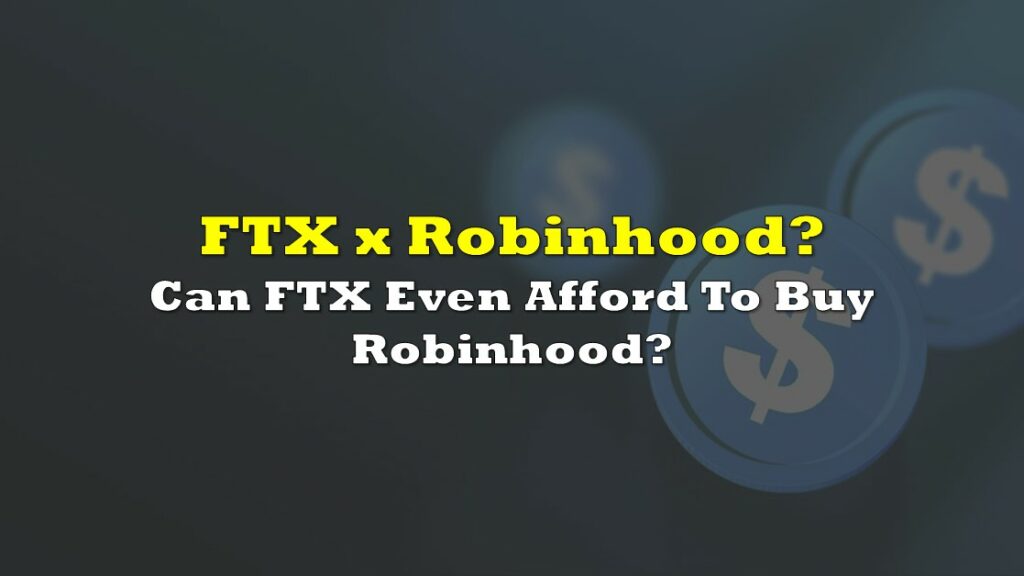On January 27, 2022 after the regular market close, Robinhood Markets, Inc. (NASDAQ: HOOD) reported earnings results for 4Q 2021. These results represented its second successive disastrous quarter in almost every respect, and its guidance for 1Q 2022 offered little hope for a change in the trend.
The stock plummeted about 12% in after-hours trading to US$10.20, bringing Robinhood’s stock market capitalization down to around US$8.9 billion. Net of its enormous US$6.25 billion of cash holdings and zero debt, the company’s enterprise value (EV) is only US$2.6 billion.
Clearly, based solely on the trajectory of its likely future cash flows, Robinhood would probably be considered overvalued even at this level — its operating cash flow deficit in 4Q 2021 alone was US$276 million, and 1Q 2022 promises to be no better. However, the company does have more than US$6 billion of cash, and the stock is down more than 85% in just under six months. Shorts in Robinhood may want to consider covering at this stock price because of the huge cash balance (which equates to about 23 quarters of cash burn at the current quarterly rate), and because it may be hard to continue to press the company’s EV much below the current levels.
A few of the disappointing details of Robinhood’s 4Q 2021 report are outlined below.
Revenue in 4Q 2021 was just under US$363 million, down slightly versus 3Q 2021 and down dramatically from more than US$520 million in both 2Q 2021 and 1Q 2021. Keep in mind that Robinhood’s 4Q 2021 revenues were against the backdrop of approximate 10% increases in both the S&P 500 and Bitcoin during this period. Unless another meme stock or cryptocurrency frenzy were to return, it is difficult to predict a movement back to revenue levels seen during the first half of 2021.
| (in thousands of US dollars, except otherwise noted) | 4Q 2021 | 3Q 2021 | 2Q 2021 | 1Q 2021 |
| Cumulative Funded Accounts (millions) | 22.7 | 22.4 | 22.5 | 18.0 |
| Sequential Growth | 1.3% | -0.4% | 25.0% | 44.0% |
| Monthly Active Users (millions) | 17.3 | 18.9 | 21.3 | 17.7 |
| Sequential Growth | -8.5% | -11.3% | 20.3% | 51.3% |
| Assets Under Custody (US$ billions): | ||||
| Equities | $72 | $69 | $73 | $65 |
| Options | $2 | $1 | $2 | $2 |
| Cryptocurrencies | $22 | $22 | $23 | $12 |
| Net Cash Held by Users | $2 | $3 | $4 | $2 |
| Assets Under Custody (US$ billions) | $98 | $95 | $102 | $81 |
| Sequential Growth | 3.2% | -6.9% | 25.9% | 28.6% |
| Average Account Balance (US$) | $4,241 | $4,533 | $4,500 | |
| Sequential Growth | -6.4% | 0.7% | -10.7% | |
| Average Revenue Per User (US$) | $64 | $65 | $112 | $137 |
| Sequential Growth | -1.5% | -42.0% | -18.2% | 29.2% |
| Options PFOF Revenue | $163,000 | $164,000 | $164,604 | $197,860 |
| Cryptocurrency PFOF-Type Revenue | $48,000 | $51,000 | $233,103 | $87,587 |
| Equities PFOF Revenue | $52,000 | $50,000 | $52,012 | $133,301 |
| Other PFOF Revenue | $1,000 | $2,000 | $1,448 | $1,691 |
| PFOF or PFOF-Type Revenue | $264,000 | $267,000 | $451,167 | $420,439 |
| All Other Revenue | $99,000 | $98,000 | $114,166 | $101,735 |
| Net Revenue | $362,713 | $365,000 | $565,333 | $522,174 |
| Sequential Growth | -0.6% | -35.4% | 8.3% | 64.4% |
| Adjusted EBITDA | ($86,844) | ($83,999) | $90,173 | $114,771 |
| Cash | $6,253,477 | $6,166,705 | $5,077,752 | |
| Debt – Period End | $0 | $0 | $7,369,522 | |
| Shares Outstanding (millions) | 863.9 | 835.7 | 225.8 | 225.6 |
In this same vein, monthly active users fell to 17.3 million in 4Q 2021 versus 18.9 million in 3Q 2021 and 21.3 million in 2Q 2021. Perhaps more ominously, monthly revenue per user stagnated in the US$64 range, down a startling 43% from US$112 just two quarters ago.
Robinhood’s adjusted EBITDA was negative US$87 million in 4Q 2021. This brings its full-year 2021 adjusted EBITDA to a small positive value of US$34 million. Robinhood’s EV-to-EBITDA ratio, a key valuation benchmark for growth companies, is 76x, an extremely high figure.
Management provides little reason for optimism in the near term. The company projects that 1Q 2022 revenues will be less than US$340 million, or down 6% or more from the depressed 4Q 2021 levels. Even this forecast presumes an uptick in trading volumes from that seen so far in January 2022.
Even more discouraging, cash operating expenses, excluding non-cash stock-based compensation, are projected to increase a remarkable 15%-20% in the full year 2022 versus 2021. Belt-tightening evidently is not to be employed in 2022.
Having discussed all these less-than-constructive data points, it is difficult to adopt a positive view of Robinhood’s fundamentals. Nevertheless, it still seems that counting on further declines in Robinhood shares from an already depressed base feels a bit like pressing one’s luck too hard.
Robinhood Markets, Inc. last traded at US$12.73 on the NASDAQ.
Information for this briefing was found via Edgar and the companies mentioned. The author has no securities or affiliations related to this organization. Not a recommendation to buy or sell. Always do additional research and consult a professional before purchasing a security. The author holds no licenses.









